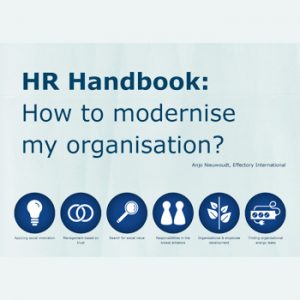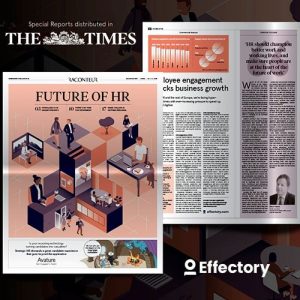The term “organizational development” was at one time often understood to be referring to restructuring. It conjured up images of major projects to implement change — the kind of change undertaken once in a blue moon. How different things are these days. Modern organizations are in perpetual motion, evolving day and in day out to keep pace with the latest market developments. Agility, innovation and creativity are more important than ever before.
Organizational development: Perpetual motion

The biggest fear of many leaders is being overtaken by an innovative idea from a startup company from one day to the next, in a move that nobody even saw coming. That may sound unlikely, but it happens every day.
Two prime examples are the impact that Netflix has had on the DVD market and the influence of WhatsApp on the SMS bundles offered by the traditional telecoms giants. Any organization wishing to prevent this kind of scenario must make organizational development part of its daily routine. Simply restructuring once a year is no longer sufficient to keep up with the lightning-fast pace at which the world develops in the 21st century.
Organizational development and change management
One big challenge facing many executives is how to ensure that the organization continually develops and stays relevant. How do you stay up to date on the latest news and ensure that you don’t miss any technical updates? How do you stay attuned to what your customers want and ensure that you’re not overtaken by innovations from competitors? The answer is simple: Commit to moving the process of organizational development outside of the confines of the boardroom. You need to capitalize on all of the eyes and ears that you have at your disposal. Every employee within your organization can and must play a part.
Given this background, change management has become a whole new ball game. It is no longer solely the domain of the Board of Directors; it is now a perpetual process to which the entire organization contributes. Successful organizations have been looking at change management differently for some time now. They adapt a little every day, which means that they never need to restructure.
Fundamental organizational development processes
So how do you shape continuous organizational development? Essentially, the process comprises three steps:
1. Start with your mission statement; this is the core of your organization
What do you want to contribute to the world? Why does your company exist, or why would you set it up if it hadn’t yet come into existence? Make sure that you have a clear mission statement down on paper. Keep this goal in mind and think critically about whether everything you are doing is actually moving you toward the goal.
2. What do customers want from you? Why do they choose you?
Does this tie in with your mission statement? Look outward. How are customers evolving? What are their wants and needs? Are you still managing to engage with customers in the places where you are represented, online or otherwise? Employees are best placed to answer these questions. They are the ones who help your customers, advise them, speak to them every day. Without input from your employees, you don’t truly have a good picture of what is going on with your customers.
3. Analyze what your key competitors are doing
Keeping an eye on the Internet is one approach, but you can also ask your customers what products or services they buy elsewhere because your organization doesn’t offer them. Here, too, ask your employees. What kind of competitor products and services are sales representatives confronted with when they get round the table with prospects? What new trends are the marketing department encountering online? Are they different or smarter than what you are offering?
These three steps will help you to decide on the right direction for your organization. Of course, you must not lose sight of the necessary framework conditions. Do you have the technical and logistics infrastructure you need to take this direction? If not, what steps do you need to take to get there? These steps will create the path for your organizational development.
Free HR Handbook: How to modernise my organisation?
How to modernise my organisation?” provides practical HR tips to get started. You will discover how your organisation can be sustainable successful.
DownloadPhases of organizational development
The approach outlined above sees us make a conscious move away from traditional strategies of phased change. Organizational development is no longer a static process in which we draw a distinction between defined phases. To keep your organization current, you need a new mindset, one that requires you to be flexible in achieving your mission statement.
The events sector is a good illustration of this point. The current situation, with our socially distanced society, has taken a huge toll on this sector, with all physical trade fairs and conventions being canceled. Yet some organizations have been less affected than others – the organizations that started paving the way for online events years ago because they saw that this was the future.
They were already taking a different approach to achieving their mission of bringing people together and sharing knowledge. This move was fueled on the one hand by technological developments actually making it possible and on the other by the fact that this is what customers have asked for. Their capacity for innovation and their creativity have ensured that they are now continuing to function successfully.
The Future of HR Special Report
Technology is changing how HR will function in the future. This report explores the impact of AI & big data plus how to use employee engagement for growth.
DownloadAn organizational development department
Is it a good idea to set up a department that is fully responsible for organizational development? Yes! Although you need input from all employees, it is a good idea to have a few people who take the lead: an innovation team.
They can coordinate the improvement process and make it a priority. The team might work on minor improvements, such as customizing the options menu for the phone, but also on bigger things, such as purchasing the latest software or developing a whole new product
Ideally, this team will have a helicopter view — circling above the organization and identifying opportunities for organizational development. The team can then zoom in and start utilizing those opportunities, but it needs input from the employees in order to do that. This feedback is best collected through social innovation. How does that work?
- The innovation team presents the employees with a number of questions relating to the organization. For example: How can we halve the time it takes to serve our customers? Or: What is the best way to sell our products online? Employees volunteer to discuss a topic of their choice. Allowing the employees to make the choice themselves means that you will be engaging with people who are genuinely interested in the topic.
- Give the employees a clear framework. For example: The cost of the solution must not exceed a specific amount and it must be possible to implement the solution within six months. This will help your employees to come up with viable ideas.
- Then just let them loose! Employees often have truly surprising input to offer and everyone views the questions about development from their own perspective.
Use the feedback from your employees
Of course, it is also very useful to ask for ideas for improvement in a more formal way in your employee survey. At Effectory, we finish each survey with the question: Can you name three areas in which you think the organization could improve? The answers are often highly pertinent and provide valuable insight to help focus your organizational development. Respond to current trends and stay alert by listening to feedback from your own employees.
Book a free demo. See our solutions in action.
Effectory is Europe’s Leading provider of Employee Listening Solutions. Schedule a product demo and discover how to enhance your employees’ engagement.
Demo request

